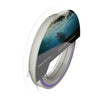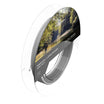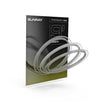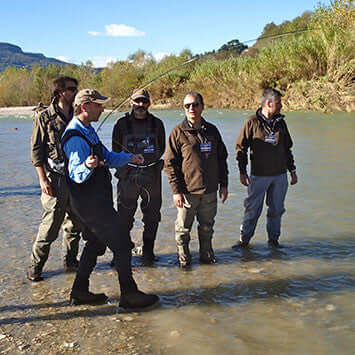Geoffrey Bucknall was the first person that I remember extolling the value of light lines combined with the Charles Ritz high line speed style of casting, I think sometime in the 1970s. At that time I mainly used a 4 weight setup which was considered by most to be very light. However over the last fifteen years I’ve gone lighter and lighter. Now my 3 weight gear is generally the heaviest that I use (even on small still waters), whilst I often use a 1 weight line combined with a 12 to 16’ leader, a 1 or 3 weight Jeremy Lucas micro-thin Presentation line with its long and delicate front taper plus a 14’ delicate dry fly leader, a 0.55mm diameter Micro-nymph line or French Nymph Leader for both nymphing and dry fly fishing (when not fishing Tenkara where the line is even lighter, just 0.285mm diameter fluorocarbon).
Why bother fishing super light fly lines?
After all they are surely much harder to cast with? I’ll dispel that myth later. So let me first extol the advantages of very light lines.
- They are less likely to scare the fish for several reasons. They land more gently. They are less visible to the fish and cast less of a shadow. They are easier to hold off the water when fishing at short range or to delay their landing when using an appropriate casting style (particularly the super light micro-nymph lines from several manufacturers and Jeremy Lucas Presentation Lines from Sunray). This can at times be very important as I’ve even seen spooky fish bolt when a 1 weight line and 15’ leader has hit the water. The ideal presentation is undoubtedly a fly-first landing with no line and the minimum of leader/tippet alighting on the water surface. With the Italian Style of casting and a light line it is possible not only to land the fly first but also to delay the landing of the line and leader, whilst with Tenkara it is possible to land fly & a short length of tippet only.
- They are easier to mend and lift off the water, improving line control and reducing disturbance when mending and lifting off to recast in situations where you have no choice but to have fly line on the water.
- Light lines, coupled with light rods and reels are much more pleasant to use.
Many of you may still be saying “but what about the problems of casting such light lines, particularly on windy days”? One of the advantages of silk lines is that being denser than plastic lines, therefore thinner than equivalent weight plastic lines they have less surface area so cut through the wind better. Most light plastic lines being thinner than heavier lines generate less wind resistance so cut through the wind more easily, but having less weight they carry less energy; as a result some modification of casting style is required. It is essential to achieve high line speed and tight loops when trying to cast a dry fly on a superlight line (or French Leader setup).
The rod must be adequately loaded to facilitate this and the rod tip must be tracked along as straight a line as possible with the minimum deviation during the tap/thrust phase of the cast. I’ve never explored the Ritz Style but the Italian Style of casting answers the problems admirably when casting dry flies or very small nymphs. The standard Italian casting stroke is long with a drift at the end of both back and forward cast and with no distinct stops. Rod acceleration is smooth but with a distinct thrust before the final drift. The thrust is more like jabbing someone with a rapier point and not a small wrist tap as seen in more usual casting styles. This generates very tight loops and high line speed whilst avoiding tailing loops. So much energy is generated that it requires at least one line weight lighter than the rod is designed for (I fish a 3 weight line on a 4/5 weight rod and a 1 weight on a 2 weight rod).

4lb 14oz brown trout taken on a 3 weight Italian Casting set up & 16’/5m leader on a day when the headwind was gusting at 45mph
Furthermore since the casting stroke is aimed at the water (rather than above the water) a long tapered leader (5m, 16’) is needed to fully dissipate the casting energy before the fly hits the water. The advantages of this are two fold; firstly a fly-first presentation ensures that the fish senses the fly landing before the line lands, ensuring that the fish focuses its attention on the fly and not on the potentially scary line landing; secondly if the tippet, leader and line landing are delayed so is drag (with a conventional cast the line lands first, then the leader and drag has already set in well before the fly lands).
Italian Style of Fly Casting
There is one big drawback of the Italian Style and that is it requires completely relearning your casting style. If like me you’ve cast conventionally for many years it can take a few days of tuition and practice to break the inbuilt muscle memory. However it is well worth the effort. Although the Italian Style evolved for fishing dry fly in turbulent alpine rivers with short, (7’ 6”) relatively stiff rods I have found that it has improved my casting with longer, softer rods and when casting French Leaders or ultra-light presentation lines such as Sunray’s Jeremy Lucas Presentation lines.

2lb 12oz grayling taken on Tenkara gear
I mentioned earlier that MOST plastic lines are thicker and less dense than silk lines, however Sunray has brought out a range of micro thin fly lines designed to combine all the advantages of plastic lines with all those of silk lines. Silk lines, although they are denser than water, float thanks to a treatment with hydrophobic (water-hating) Mucilin or similar floatant. Sunrays' lines, like silk, are also denser than water but float thanks to the high-tech hydrophobic plastic coating and just as silk lines need re coating with floatant Sunray lines need to be kept clean so that the inbuilt coating is not rendered ineffective by a layer of dirt which is hydrophilic (water-loving).
Another problem that you might envisage with light lines is that rods designed to cast super-light lines must have a soft enough action to load and therefore might well be too soft to land big fish. This may well have been true many years ago with full-flex rods that bent down to the butt, however modern progressive actioned rods designed for light lines have enough guts in the lower sections to cope with all but the biggest of trout. I’ve happily landed 5lb plus trout on my 1 weight rod without prolonging the battle to the point where it endangered the trout’s survival chances when released. Furthermore, if you adopt the Italian Style of casting it is possible to use a rod rated 1 or even 2 line weights heavier than your chosen line.
Good presentation is paramount if consistent success is to be achieved and to achieve this requires both skill and the right setup of rod, line and leader. Optimum presentation is also only really achievable at close range and you don’t need clumsy 5 weight lines to fish at a distance of 10m/30’ or less. I must confess that I often go fishing with just one rod and line set up, choosing a compromise that will cope with a range of surface and subsurface fishing styles, but even so I fish with the lightest line that will cope with the conditions. It really does make a big difference! If you haven’t done so before give super-light lines a try, you’ll not regret it.

Manu Gonetto showing the deep loading of an Italian Style rod during the thrust phase of the backcast with a 3 weight line on a 4/5 weight rod.
Anyone interested in learning the Italian Casting Style can contact FFM UK through their Facebook page https://www.facebook.com/groups/369903959751595/
Hopefully FFM UK will soon have a website set up.
































